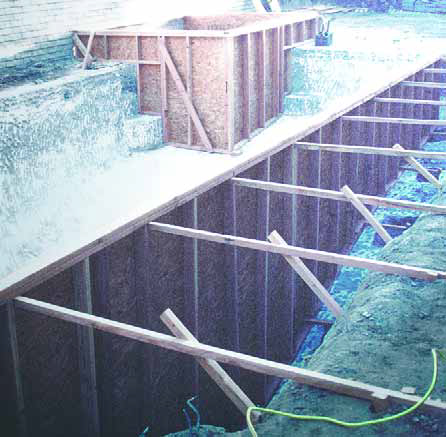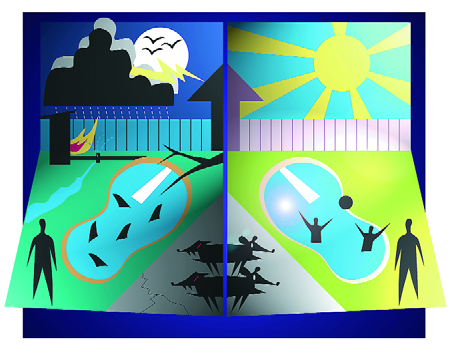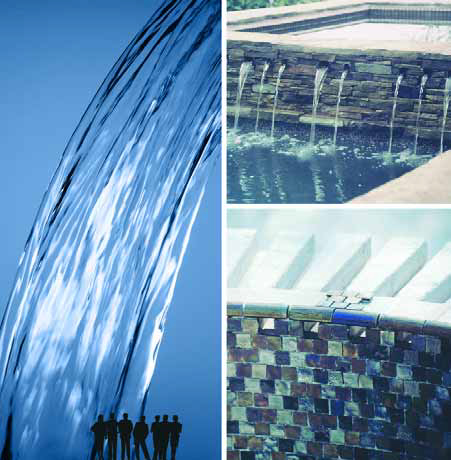pool design
One of the things I like most about working with water is that it makes statements that don't require much verbal explanation. In fact, I like to think that the projects I build speak volumes about my clients' desire for something creative and interesting. They also speak to the point that most of my clients grant me the freedom to give my very best effort, both aesthetically and technically, without many constraints. Not all the work I do is so modern in style or approach as the project pictured in these pages, but this one illustrates a principle that's become a
Last time, I mentioned initial meetings and discussions having to do with a retrofit project in Pacific Palisades, Calif. I call it a "retrofit" because we're using a portion of an existing pool shell as part of the new one, but in truth this is really a ground-up reworking of the entire environment. This project displays the influence that architects Ricardo Legoretta and Luis Barragan have had on my thinking about shapes, colors and spatial relationships. As soon as I saw this place, in fact, the work of both came to mind because of the strong colors and materials and the expressive
Is it honest to say that too few of the swimming pools you find in America's backyards are what one could call well built - and that even fewer of them are well designed? I think so, because so many of the pools I see run like junk and look like junk, and it's way too easy to find installations that lack any apparent relationship to their settings, their homes' architecture, the landscaping or any recognized
I'm always looking for projects where I'm brought in to design the entire exterior environment, complete with hardscape, planting plans and watershapes. Working this way gives me a straight shot at integrating all of these major elements into cohesive designs that fit the setting. But I believe in collaboration, too, and in giving interested clients an opportunity to participate in the process. I listen carefully to what they say, factor in their budgets and then start working toward a suitable design. This integrated approach often requires intensive and extensive interaction with homeowners. Through it all, I'm flexible - but I'm also confident in my abilities, experience and expertise and generally end up installing something that closely matches my sense of the way things should be. When it works, everything goes smoothly. In the case of the project pictured in these pages, however, the process has been much more involved and is, 18 months into it, still ongoing in
One of the skills of a good designer is the ability to recognize those situations in which less is more. The detail pictured in these pages, for example, shows how the choice to go with a small volume of moving water (as opposed to a torrent) can add immeasurably to a composition's visual strength. Using this understated approach helps the designer or builder avoid what has become one of the biggest clichés of modern pool design - that is, the outsized waterfall spilling over a single weir from a raised spa into an adjacent swimming pool. My desire to get away from that monotonous
Everyone is concerned these days about electricity, gasoline and natural gas and all other forms of energy. What is amazing is that, despite this surge in interest, very few people have considered ways in which swimming pools can be built to reduce the energy required to heat them - and by substantial amounts. This dearth of energy consciousness has nothing to do with the manufacturers of heating equipment. It's fair to say that most heater manufacturers - whether they pursue combustion heating with fossil fuel, compression heating with heat pumps or passive heating with radiant solar, absorbent solar panels or solar covers - all have optimized their own products and made them remarkably energy-efficient. The same is true of recirculation systems: Pumps of all kinds are optimized to very high efficiencies, and the pool and spa industry has made positive improvements in acknowledging the necessities of hydraulic efficiency (although it's fair to say we
The consumer's appetite for beautiful water and creative watershape design has grown by leaps and bounds in recent years - and expectations, it seems, are rising right along with the hunger for exceptional details and impressions. Perimeter-overflow pools and basins are what an increasing number of consumers are after these days, and there's special interest in what are called "wet-edge applications," where the water rises to deck level and flows into a channel slot at the back edge of the coping. It's an amazing look - and harder to
What do you call the effect of water falling over the edge of a pool? Do you say it has a negative edge? An infinity edge? A vanishing edge? Or do you have
Helena Arahuete joined the staff of John Lautner's architectural firm in the early 1960s, at a point where he was turning out some of his most spectacular work. Indeed, Lautner can indisputably be said to have designed some of the most beautiful and unusual homes built in the second half of the 20th Century. An apprentice of Frank Lloyd Wright's who studied with the master at Taliesen, Lautner was an exponent of the philosophy and discipline known as "Organic Architecture," an approach Arahuete, now an eminent architect in her own right, has continued to use and refine while running the firm that still bears Lautner's name. She is now one of the world's leading practitioners of Wright's and Lautner's approach to creating unique structures that are intricately and intimately tied to their surroundings. She is also so firm a proponent of the integration of watershapes into those architectural forms that in April 2000, she carried her message to the first Genesis 3 Level II Design School, held in Islamorada, Fla. - and welcomed an opportunity to present some of Lautner's work here by way of defining the place watershapers have at the design table with
I believe that what we strive for in our watershapes is evident in the paintings and sculpture of the great masters. The harmony, the beauty, the drama, the excitement of the senses, the total captivation of the viewer create an experience we call great art. The more we can reflect on this work and use it as a lofty benchmark, the more effective our watershapes become. I've always believed that the best way to work at the highest level is to follow the tenets of






















